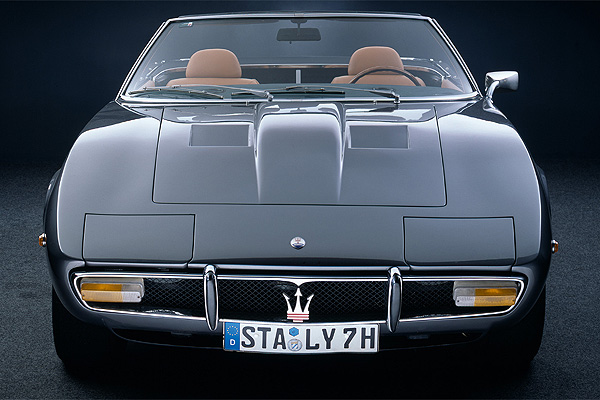The Greatest Maserati's
|
Valued at $650,000 Start of Production: 1966 End of Production: 1973 Length: 4,690 mm Width: 1,800 mm Height: 1,160 mm Wheelbase: 2,550 mm Weight: 1,300 kg Engine: V8, front, longitudinally mounted Power: 242 kw (330 hp) at 5,500 rpm Top Speed: 265 km/h Transmission: manual 5 speed or automatic |
| 1969 Maserati Ghibli Spyder | |
|
In 1967 Maserati presented its new coupé, the
Maserati Ghibli, following it up two years later, in 1969, with the
open-top version, the Maserati Ghibli Spyder, two vehicles that would
rewrite the history of road cars. The Maserati Ghibli was a sports car
proposed in the coupé or spyder variant with a front-mounted engine and
the dimensions of a real supercar. The hood, long and tapered, projected
forward with sleek lines that concealed the headlights and sophisticated
racing world technology. Together with the Maserati Simun, the Maserati
Ghibli Spyder was one of the final projects designed by Giorgetto
Giugiaro at Ghia before he opened Italdesign Giugiaro in 1967. The steel
bodywork of the Maserati Ghibli Spyder was constructed by the Vignale
factories in Grugliasco before being assembled with the mechanical parts
of the car constructed in Modena Maserati built only 125 Maserati Ghibli Spyders between 1969, the year the model was launched on the market, and 1973, when it was replaced by the Maserati Khamsin. The 2-seater boasted highly elegant lines and extremely refined solutions: the fabric roof, for example, could be folded into a compartment covered by a special panel to give the open-top car a clean, tidy and sleek look. For the most demanding customers Maserati also produced a special hard top which made it easy to use the car even in the most adverse weather conditions. The large windows of the hard top gave the Maserati Ghibli an extremely unique look but fewer than 25 Maserati customers purchased it, making it into an extremely difficult-to-find accessory nowadays. In terms of mechanics, the Maserati Ghibli was based on tried and tested details, sharing many of the components with the Maserati Quattroporte and Maserati Mexico. The tubular ladder frame chassis was the evolution of the Maserati chassis and was combined with a rear axle with semi-elliptical coach springs and double-wishbone front suspension. The eight-cylinder 4.7-litre naturally aspirated engine derived from the race track and came in the dry sump version with four double-body carburettors and a timing chain with four overhead camshafts. The Maserati Ghibli Spyder could therefore count on a maximum power of 310 hp at 6000 rpm, which enabled it to achieve a top speed of 272 kilometres an hour. The new 15-inch magnesium alloy wheels were combined with a self-locking differential and a 5-speed plus reverse gearbox produced by ZF to complete the outfit, even if the price list also included a variant with a 3-speed automatic gearbox, mainly targeted at the transatlantic markets. |


